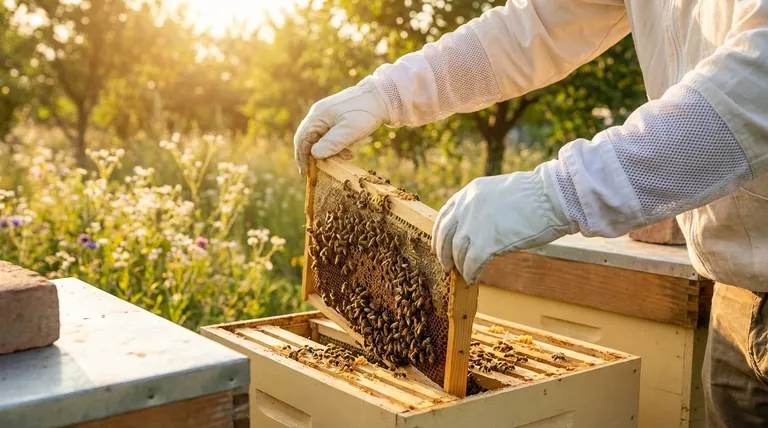Ventilated beekeeping gloves are engineered for superior comfort in warm weather. They accomplish this by incorporating breathable mesh panels into their design, typically along the gauntlets and the back of the hand. This feature allows for significant airflow, which drastically reduces heat and moisture buildup inside the glove.
The core trade-off with ventilated gloves is clear: you gain a significant increase in comfort and dexterity in exchange for a slight reduction in absolute sting protection and long-term durability compared to solid leather options.

The Core Design: Comfort Through Airflow
The primary innovation of ventilated gloves is their focus on mitigating heat and sweat, which are common complaints with traditional beekeeping equipment.
The Role of Mesh Panels
The defining feature is the use of synthetic mesh fabric. This material is strategically placed in areas less likely to come into direct contact with bees, allowing air to circulate freely while the palm and fingers remain protected by a more robust material like leather.
Reducing Heat and Sweat
By allowing moisture and heat to escape, these gloves keep your hands cooler and drier. This not only improves comfort during long hive inspections but also helps maintain a better grip and feel.
Lightweight Construction
Ventilated gloves are generally more lightweight and flexible than their all-leather counterparts. This reduction in bulk can enhance dexterity, making delicate tasks like marking a queen or manipulating frames easier.
Understanding the Trade-offs
While offering excellent comfort, ventilated gloves are not without their compromises. Understanding these limitations is crucial for making an informed decision.
Protection vs. Breathability
The very mesh that provides comfort is also the glove's primary vulnerability. While the mesh is designed to be sting-resistant, a determined bee can occasionally penetrate it, a risk that is virtually nonexistent with thick, solid leather.
Durability Concerns
Mesh fabric is inherently less durable than goatskin or cowhide. It is more susceptible to snagging on hive components, tearing over time, and showing wear more quickly with heavy use or frequent washing.
When Are Ventilated Gloves the Right Choice?
These gloves excel in specific situations where their benefits most clearly outweigh their potential drawbacks.
For Beekeepers in Hot Climates
If you conduct hive inspections in high heat and humidity, the comfort provided by ventilated gloves is a significant advantage. Reduced sweating and heat fatigue can make beekeeping a much more pleasant experience.
For Routine, Low-Intensity Work
For hobbyists with calm colonies or for routine tasks that don't involve aggressive hive manipulations, the level of protection offered by ventilated gloves is typically more than sufficient.
Making the Right Choice for Your Apiary
Your decision should be based on your climate, the temperament of your bees, and your personal tolerance for risk.
- If your primary focus is maximum protection: A non-ventilated glove made from thick goatskin or cowhide remains the superior choice, especially if you are a beginner or work with defensive colonies.
- If your primary focus is comfort in warm weather: Ventilated gloves are the ideal solution, providing you accept the slight compromise on absolute protection and durability.
- If you are on a tight budget: Be aware that the mesh on ventilated gloves may wear out faster than a solid leather glove, potentially requiring more frequent replacement.
Choosing the right glove is about aligning your equipment with your climate, your bees, and your personal comfort level.
Summary Table:
| Feature | Benefit | Trade-off |
|---|---|---|
| Breathable Mesh Panels | Increased airflow, reduces heat and sweat | Slightly less sting protection than solid leather |
| Lightweight & Flexible | Improved dexterity for delicate tasks | Lower durability; mesh can snag or tear |
| Ideal for Warm Climates | Superior comfort during long hive inspections | Best for calm colonies or routine work |
Upgrade your beekeeping comfort with HONESTBEE's ventilated gloves. Designed for commercial apiaries and distributors, our gloves provide the airflow and dexterity needed for warm-weather hive management. Let us help you equip your team with gear that balances protection and comfort. Contact HONESTBEE today to discuss wholesale options!
Visual Guide

Related Products
- Beekeeping Gloves Goatskin Leather with Long Cotton Sleeve for Beekeepers
- Goatskin Leather Beekeeper Gloves with Vent Long Sleeve for Beekeeping Honey Bee Sting Proof Protection
- Mesh Ventilated 3 Layer Goatskin Beekeepers Gloves for Beekeeping
- Goat Skin Leather Bee Sting Proof Beekeeping Gloves with Canvas Sleeve
- Professional Galvanized Hive Strap with Secure Locking Buckle for Beekeeping
People Also Ask
- What are the arguments for and against using gloves in beekeeping? Balancing Protection and Dexterity
- What is the difference between cleaning cow leather and goat leather beekeeping gloves? Tailor Your Care for Longevity
- Why do some experienced beekeepers choose not to wear gloves? For Superior Dexterity & Hive Welfare
- Why is dexterity and flexibility important in beekeeping gloves? Boost Your Hive Management Efficiency
- Why are protective gloves important in beekeeping? Boost Confidence & Safety in Your Apiary



















